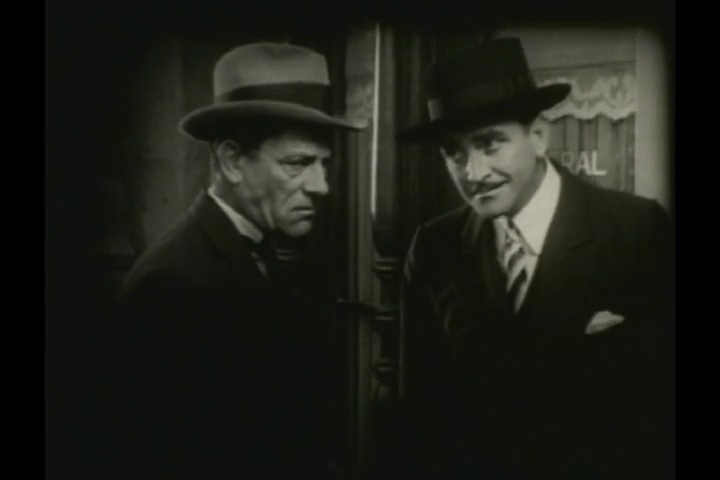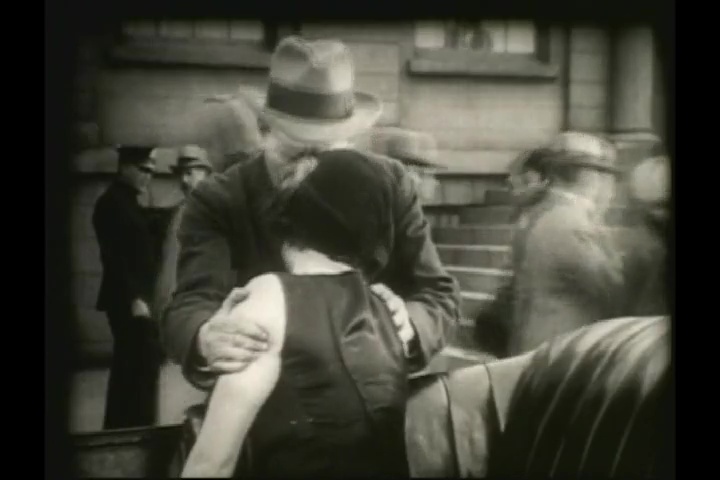Lon Chaney didn’t need makeup to play a plainclothes detective out to catch a dirty mortician who always seems to have an alibi. But made up or not, Chaney never seemed to be able to avoid getting involved in a doomed love triangle.
A big thanks to William for helping me to see this film.
Home Media Availability: No official release yet.
Romancing the Copper
While Lon Chaney is most famous for his innovative makeup and his talent for contorting his body into whatever shape the role required, he was also a dynamic and exciting performer who needed no makeup at all in order to hold the attention of his audience.
While the City Sleeps is a bit of a throwback with a twist in Chaney’s career. He established himself playing gangland heavies in a series of collaborations with Tod Browning and played a lord of the San Francisco criminal underworld in The Penalty, the picture that really established Lon Chaney as Lon Chaney. In this film, though, he’s on the opposite side of the law.
Chaney plays Dan Coghlan, a tough plainclothes detective who is hot on the trail of a crooked funeral home owner (Wheeler Oakman) who goes by the nickname Mile-Away because he always manages to produce the solid alibi of being “a mile away” from any crime. Coghlan is also trying to keep his young friend Marty (Carroll Nye) out of trouble as he is a good kid who just runs with the wrong crowd.
Marty is dating Myrtle Sullivan (Anita Page), a vivacious flapper who has known Coghlan for years. She also enjoys running with the wrong crowd but Coghlan keeps a close eye on her. Mile-Away also is observing Myrtle and plans to get rid of Marty in order to get her for himself. And, in a shocking plot twist, old family friend Coghlan is also in love with Myrtle.
Bessie (Mae Busch) is Mile-Away’s jilted girlfriend and she has enough information to send him up the river. Coghlan finally convinces her to talk by playing on her jealousy and anger at being dumped in favor of Myrtle and she tells all. Unfortunately, Mile-Away has her murdered before the case can go to court.
With his young friends in peril and his only witness dead, Coghlan must find a way to lock Mile-Away behind bars where he belongs.
One thing that struck me as I was watching this film was how it contrasted with the police and gangster pictures of the 1910s. Films of that time were more likely to condemn the police for employing the “third degree” or aggressively pursuing a suspect on instinct alone. (The Doll-House Mystery is a good example of this.) While the City Sleeps follows the pattern that would soon become the standard in police movies: rights for suspects interfere with good police work and if the suspect needs to be beaten, so be it. The hunch always proves to be worth it.
(I should note that there was always pushback against that attitude with the 1951 film On Dangerous Ground being a particularly fine example but in general, police brutality has been winked at in mainstream American films.)
So, While the City Sleeps is both a throwback for its star and a glimpse of the future of the genre. Chaney does excellent work as the grizzled old cop who will do anything to make an arrest. The climactic raid is genuinely exciting and director Jack Conway deserves credit for that. There are also some thrilling sequences in the middle of the picture with Chaney taking on Mile-Away’s entire gang singlehanded.
The film also has a nice, lived-in feel to it and if you spliced a few scenes into a documentary about Warner Bros. gangster pictures, I doubt anyone would be able to notice much difference. There are also some details about 1920s police work (suspects paraded in a large shadow box) and, of course, Mile-Away’s funeral home is the perfect cinematic villain headquarters.
I should note, though, that no complete print of this film is known to survive and surviving copies have missing footage, particularly in the final third of the picture. Therefore, I am not going to harp too much on what is and is not included in the film as it may very well have been in the missing bits.
As characters, Myrtle and Marty aren’t going to split the atom and they’re probably made for each other but Anita Page is the charming essence of flapperhood. I think perhaps the viewer’s enjoyment of this picture may be influenced by how many Chaney vehicles they have seen. Page is a vivacious and appealing performer but Chaney’s sad (if somewhat predatory) affection for the young woman he saw grow up is very much been-there-done-that. Chaney had loved and lost a teenage Loretta Young on Laugh, Clown, Laugh just a few months before.
Chaney benefitted from variety and it’s no coincidence that some of his best performances sidestep the jealous lover trope or focus on the jealousy rather than the love. (The Penalty and West of Zanzibar come to mind, my two favorite Chaney pictures. And he just wanted to do a bit of mad science on Gertrude Olmstead in The Monster, which makes it a real breath of fresh air.) There’s nothing wrong with the way Chaney and Page handle their scenes as performers, though I would have liked his character courting a young woman under the color of authority to be interrogated a bit more.
This picture is something of a reunion with veteran Chaney co-stars Mae Busch and Wheeler Oakman in the cast. Busch played the tough girl object of Chaney’s affections in the silent version of The Unholy Three and Oakman co-starred with Chaney and Priscilla Dean in the 1920 Tod Browning picture Outside the Law. (It has just received a sparkling new restoration and re-release as of this writing.)
Busch is best remembered for her game performances in Laurel and Hardy classics like Sons of the Desert and Oliver the Eighth but in the silent era, she was both comedienne and dramatic performer. (She played an off-brand Viola Dana in Souls for Sale, having lost her aviator true love in a tragic accident.) Frankly, she makes a stronger impression than Page and it’s a darn shame that her character is offed almost instantaneously and off-screen to boot!
Oakman worked steadily throughout the silent era and into the talkies and he does good work as Mile-Away. Gangster roles were not new to Oakman but he easily swung between gunsels, naïve goodie-two-shoes (as he was in Back to God’s Country and Peck’s Bad Boy), and supporting players. He never really had a screen persona you could put your finger on but his versatility was likely the key to his longevity.
While the City Sleeps is a quality gangster picture with plenty of atmosphere adventure and tough talk. Lon Chaney gives a powerful performance but the film would have been much stronger if it had not been written as a Chaney vehicle. The old “he loves her, so he lets her go” trope was really starting the wear thin and didn’t do anything to showcase Chaney’s versatility.
Still this is a strong entry in Chaney’s filmography, especially when viewed in context of his earlier work as a gangland tough guy. Here’s hoping either the copyright holder or (eventually) the public domain will allow for a proper release.
Where can I see it?
No official home media release as of yet. It pops up online sometimes but I cannot provide links to unofficial releases.
☙❦❧
Like what you’re reading? Please consider sponsoring me on Patreon. All patrons will get early previews of upcoming features, exclusive polls and other goodies.
Disclosure: Some links included in this post may be affiliate links to products sold by Amazon and as an Amazon Associate I earn from qualifying purchases.










Excellent review!
Thank you!
Thank You Fritzi, I’m a big Chaney fan. I hope I can get a chance to see this one.
It’s definitely worth it
Great review. It’s amazing someone reviewed this at the start of 2021., in my opinion this a really more obscure title, but a worthy rare find for hardcore film buffs.